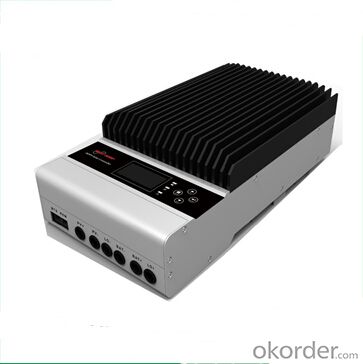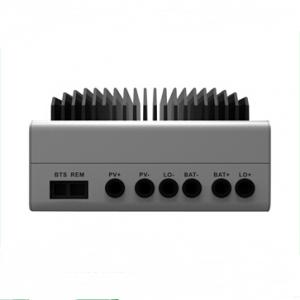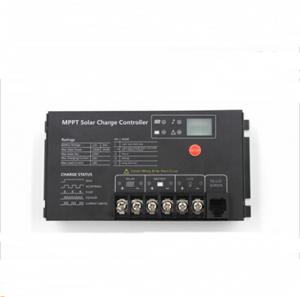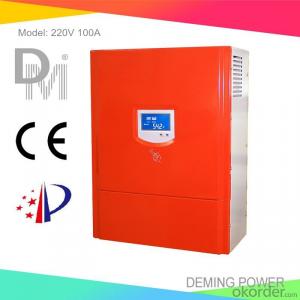Solar Charge Controller PC1600F SeriesMade
- Loading Port:
- China Main Port
- Payment Terms:
- TT or LC
- Min Order Qty:
- -
- Supply Capability:
- 10000 unit/month
OKorder Service Pledge
OKorder Financial Service
You Might Also Like
Product Description:
Features:
45A/60A MPPT Solar charge controller
PV input :145V Max
12V/24V/36V/48V auto work
MPPT efficiency>99%,Peak conversion efficiency >98%
DSP processors technology ensure high speed and performance
Four-stages charging mode
Protection: PV array short circuit , PV reverse polarity , Battery reverse polarity , Over charging , Output short circuit
Model | PC1600-1 | PC1600-2 | |
Battery System Voltage | 12V/24V/36V/48 VDC (adjustable) | ||
Charge Input | |||
PV Open Circuit Voltage | Operational max = 145VDC temperature corrected VOC | ||
Max PV Input Power(12V) | 600W | 800W | |
Max PV Input Power(24V) | 1200W | 1600W | |
Max PV Input Power(36V) | 1800W | 2400W | |
Max PV Input Power(48V) | 2400W | 3200W | |
Battery Voltage | |||
Nominal Voltage | 12VDC/24VDC/36VDC/48VDC | ||
Absorption Voltage | 13.5VDC/27.0VDC/40.5VDC/54.0VDC | ||
Refloat Voltage | 13.7VDC/27.4 VDC/41.1VDC/54.8VDC | ||
Float Voltage | 14.3VDC/28.6 VDC/42.9VDC/57.2VDC | ||
Low Voltage Protection Point | 10.5VDC/21.0 VDC/31.5VDC/42.0VDC | ||
DC Output | |||
Output Voltage | 11.0~14.3VDC/22.0~28.6VDC/33.0~42.9VDC/44~57.2VDC | ||
Max Charging Current | 45A amps continuous @ 40°C ambient | 60 amps continuous @ 40°C ambient | |
Warning for low voltage | 11.5VDC/23.0 VDC/34.5VDC/46.0VDC | ||
Cutoff for low voltage | 10.5VDC/21.0 VDC/31.5VDC/42.0VDC | ||
Low voltage recovery | 11.5VDC/23.0VDC/34.5VDC/46.0VDC | ||
Display | |||
LED indication | Systematic operation, LV indication, LV protection, over charge protection, loads protection, short circuit protection | ||
LCD display | Charge voltage, charge current, voltage of battery, capacity of battery, output current | ||
Alarm | PV array short circuit protection, PV reverser polarity protection | ||
Battery reverse polarity protection, Over charging protection | |||
Output short circuit protection | |||
Low voltage protection for storage battery | |||
General specification | |||
Environmental Rating | Indoor | ||
Charge mode | MPPT, PWM, constant current—constant voltage, function of automatic protection for storage battery | ||
Radiating mode | Fan cooling | ||
Working mode | Four stage: Absorption CC, Absorption CV, Float CC, Float CV. | ||
Peak Conversion efficiency | 98% | ||
Environment | |||
Environmental temperature | -25°C ~55°C | ||
Ambient humidity | 0--90%,No condensation | ||
Altitude | ≤3000m | ||
Dimension | |||
W*H* D(mm)/G.W(kg) | 167.6*257.1*82.9mm/3kg | 390*365*364mm(5pcs/carton) | |

Warrenty
provides a 1~3 year limited warranty (“Warranty”) against defects in materials and workmanship for its Uninterruptible power supply, Power inverter/chargers, Solar charge controllers, Battery Products (“Product”).
The term of this Warranty begins on the Product(s) initial purchase date, or the date of receipt of the Product(s) by the end user, whichever is later. This must be indicated on the invoice, bill of sale, and/or warranty registration card submitted to MUST-Solar. This Warranty applies to the original MUST-Solar Product purchaser, and is transferable only if the Product remains installed in the original use location.
FAQ:
Q1. What is the voltage?
A1. Our 45/60A solar charge controller is 12/24/36/48V auto work.
Q2. What is the difference between MPPT&PWM?
A2. MPPT has higher efficiency, it can track the max power point and won't waste energy.
Q3. What is the efficiency of the MPPT controller?
A3. MPPT>99%, peak conversion efficiency>98%.
Q4. What is the waranty of product?
A4. 12 months.
Q5. What protection does your MPPT controller have?
A5. PV array short circuit, PV reverse polarity, Battery reverse polarity, Over charging, Output short circuit.
- Q:Can a solar controller be used with a solar-powered battery charger?
- Yes, a solar controller can be used with a solar-powered battery charger. A solar controller, also known as a charge controller, is designed to regulate the charging process of a battery using solar panels. It helps prevent overcharging and over-discharging of the battery, which can damage the battery and reduce its lifespan. When used together with a solar-powered battery charger, the solar controller ensures that the battery is charged efficiently and safely, maximizing its performance and longevity.
- Q:How do I troubleshoot a solar controller that is not working?
- To troubleshoot a solar controller that is not working, start by checking the connections and ensuring they are secure. Then, verify that the solar panels are receiving adequate sunlight and the battery is properly connected. Next, inspect the controller for any visible damage or loose components. If everything appears fine, check the controller's manual for any specific troubleshooting steps or error codes. If the issue persists, it may be necessary to contact the manufacturer or seek professional assistance for further diagnosis and repair.
- Q:Can a solar controller be used with solar-powered drones?
- Yes, a solar controller can be used with solar-powered drones. A solar controller is an essential component of a solar power system that manages the flow of electricity from the solar panels to the battery. In the case of solar-powered drones, the solar controller would regulate the charging of the drone's battery using the energy generated by the solar panels. This ensures that the battery is charged efficiently and prevents overcharging or damage to the battery. Furthermore, the solar controller can also provide important monitoring and protection functions, such as temperature compensation and over-discharge prevention, which are crucial for the safe and optimal operation of the drone. Overall, a solar controller is a valuable tool for integrating solar power into drone systems, enabling longer flight times and more sustainable operations.
- Q:Can a solar controller be used with solar-powered ventilation systems?
- Yes, a solar controller can be used with solar-powered ventilation systems. The solar controller regulates the flow of power from the solar panels to the ventilation system, ensuring optimal performance and efficient utilization of solar energy. It helps control the voltage and current supplied to the ventilation system, preventing overcharging or undercharging of the batteries, and maximizing the system's overall effectiveness.
- Q:Can a solar controller be used with a battery bank that is being used for other purposes (e.g., powering appliances, lighting)?
- Yes, a solar controller can be used with a battery bank that is being used for other purposes such as powering appliances and lighting. The solar controller's main function is to regulate the charging and discharging of the battery bank to ensure optimal performance and longevity. It can efficiently manage the power flow from solar panels to the battery bank, allowing it to be used for various applications while still maintaining a stable power supply.
- Q:What is the maximum load current in standby mode of a solar controller?
- The maximum load current in standby mode of a solar controller typically depends on the specific model and its design specifications. However, the load current in standby mode is usually very minimal, often around a few milliamperes or even less. This low current ensures that the solar controller consumes minimal power while in standby, maximizing energy efficiency.
- Q:Can a solar controller be used with both 12V and 24V systems?
- Yes, a solar controller can be used with both 12V and 24V systems. Most solar controllers are designed to automatically detect the voltage of the system they are connected to and adjust accordingly. This flexibility allows them to be used with various battery systems, making them suitable for both 12V and 24V setups.
- Q:Solar water heater all intelligent controller how to install
- This is the most widely used solar water heater installation program, the solar energy operation by the solar controller 8 control, when the solar water heater tank water level below the minimum water level, the controller to open the solenoid valve 1, making the water tank, When the water level rises to the user set the highest water level, the controller closes the solenoid valve 1, the water stops. The user can specify the water time, when the specified time to, as long as the water level does not exceed the maximum water level, the controller will open the solenoid valve 1 water until the water level to the highest water level. The controller can also manually force the water: When the manual water key is pressed, the controller opens the solenoid valve until the water level reaches the highest water level.
- Q:What is the maximum load power that a solar controller can handle?
- The maximum load power that a solar controller can handle depends on the specific model and its design specifications. Generally, solar controllers are designed to handle a range of load powers, which can vary from a few hundred watts to several kilowatts. It is crucial to consult the product manual or specifications provided by the manufacturer to determine the maximum load power capacity of a particular solar controller.
- Q:What is the purpose of the load output on a solar controller?
- The load output on a solar controller serves the purpose of supplying power to a connected load, such as lights or small appliances, directly from the battery of the solar panel system. This feature allows for the utilization of solar energy when the sun is not shining or when the solar panel system cannot generate sufficient power to meet the load requirements. By directly connecting the load to the battery, the solar controller ensures a consistent and stable power supply to the load, thus maximizing the efficiency and reliability of the solar system. Moreover, the load output often incorporates various protection features, including overcurrent and overvoltage protection, to safeguard the connected load from potential damage. In summary, the load output on a solar controller enhances the functionality and versatility of a solar panel system by enabling the utilization of solar energy even in less favorable conditions for power generation.
1. Manufacturer Overview |
|
|---|---|
| Location | |
| Year Established | |
| Annual Output Value | |
| Main Markets | |
| Company Certifications | |
2. Manufacturer Certificates |
|
|---|---|
| a) Certification Name | |
| Range | |
| Reference | |
| Validity Period | |
3. Manufacturer Capability |
|
|---|---|
| a)Trade Capacity | |
| Nearest Port | |
| Export Percentage | |
| No.of Employees in Trade Department | |
| Language Spoken: | |
| b)Factory Information | |
| Factory Size: | |
| No. of Production Lines | |
| Contract Manufacturing | |
| Product Price Range | |
Send your message to us
Solar Charge Controller PC1600F SeriesMade
- Loading Port:
- China Main Port
- Payment Terms:
- TT or LC
- Min Order Qty:
- -
- Supply Capability:
- 10000 unit/month
OKorder Service Pledge
OKorder Financial Service
Similar products
New products
Hot products
Hot Searches
Related keywords






























